
By Karen Rubin, Travel Features Syndicate, goingplacesfarandnear.com
(On September 3, 2016, President Obama traveled to Hangzhou, China for a ceremony in which the United States and China formally joined the Paris Agreement. This is sure to spark interest in visiting this enchanting destination that I so enjoyed experiencing a few years ago. This story was originally published in 2008.)
From the first glimpse of West Lake, you are caught under the spell of Hangzhou, once China’s capital city. Both ancient and modern, you feel you are communing with Marco Polo who must have stood on this shore as I am, looking out at the silhouette of a wooden boat on the flat water against the backdrop of a pagoda and mountains, receding in haze in the distance.
Marco Polo called it “The City of Heaven.”
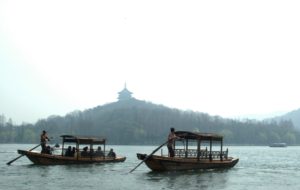
Hangzhou is at the very end of the Grand Canal, which extends 1800 kilometers from Beijing; it is where silk has been produced for 5,000 years, where for centuries, the green tea grown on the mountain side has been used by the Emperor and still is the official tea of the government. A great river, the Qiantang, flows to the sea. Its West Lake has inspired philosophers, poets, artists, music, folklore and legend.
And for me, Hangzhou and the larger Zhejiang Province, is like a microcosm of China. It seems that all the significant elements we associate with China, from silk to tea, ceramics to calligraphy to traditional medicine, Buddhism to Cultural Revolution to capitalism, are associated with this place, but on manageable scale.
If you only have a week (and I only had five days in China), this is the place to come to capture the essence of this fantastically dynamic and complex country.
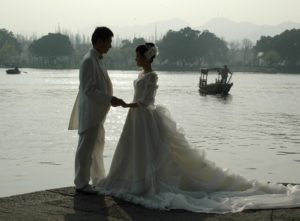
A two-hour drive south of bustling Shanghai, China’s most cosmopolitan and commercial city, Hangzhou, with a population of 1.5 million in the downtown and 6 million more in the surrounding areas, is at a slower pace – no doubt because of the calming effect of the scenic beauty and open space. It is a resort city, especially popular as a respite for Shanghai residents, the place for weddings and honeymoons, exuding romance, where the music, legends and folklore of the Chinese “Romeo & Juliet” abound.
Hangzhou and the Zhejiang Province is also an exemplary place to see modern China – how people work and live, the schools and offices and shops.
The first thing you notice when you leave from the modern Hangzhou International Airport for the 40-minute drive into downtown by a modern highway are the farming communities – tall (four and five stories high) townhouse-looking dwellings that apparently house extended families beside small fields. They are actually charming in their way – with the classic curved roofs at the top and a cupola that provides respite in the summer heat.
Typically, there is a backdrop of high-rise apartment buildings, as well. In the city, some of these large office and apartment buildings are actually showing some architectural aesthetic, rather than the institutional blandness that followed the building boom of the 1980s.
The number of cars is shocking – the city is a ribbon of massive boulevards of six lanes or so– with people on mopeds, motorcycles and bicycles trying to compete.
Despite the number of cars, Hangzhou does its best to be a “green city” – all along the new roads and even highways, there is greenery and bike lanes (the citizens even chose the color green for their taxi cabs).
I get my first view of the Grand Canal as we enter the city. The Grand Canal is considered to be the China’s greatest engineering wonder next to the Great Wall. The earliest and longest man-made waterway in the world, it dates back 2400 years and was completed into Hangzhou in 1293 A. D. It is 21 times longer than the Panama Canal, 10 times the size of the Suez Canal and 2000 years older. It was the political belt that allowed rulers to centralize power, maintain a feudal society and dominate the nation. It would take the Emperor three months to sail from Beijing to Hangzhou. In recent years, the section around Hangzhou has been renovated and extended to meet the Qiantang river and a museum, three parks and two public squares have been opened.
We arrive at my hotel, the Capital Star, a four-star business hotel outside the resort section around West Lake. It is beside narrow waterway, which is lined on both sides with a greenway, where people come out to do tai chi. My room on the 10th floor looks out to the river and faces into an apartment building.
I stay just long enough to drop my bags so that we can spend a couple of hours touring. We drive beside the West Lake on our way to visit a famous Buddhist temple, Lingyin.
But that first look of West Lake – the willows dipping toward the water, the row boats on the lake, blossoming trees – is so captivating, I have to stop.
In its thousands of years of history, Hangzhou, once China’s capital city, has had many names. Marco Polo referred to it as Kinsay, as he related:
“Inside the city there is a Lake which has a compass of some 30 miles [he probably meant 30 li] and all round it are erected beautiful palaces and mansions, of the richest and most exquisite structure that you can imagine, belonging to the nobles of the city. There are also on its shores many abbeys and churches of the Idolaters. In the middle of the Lake are two Islands, on each of which stands a rich, beautiful and spacious edifice, furnished in such style as to seem fit for the palace of an Emperor. And when any one of the citizens desired to hold a marriage feast, or to give any other entertainment, it used to be done at one of these palaces.”
This is the same scene that I come upon West Lake, a designated National Scenic Area. In an instant, was swept under this city’s spell just as Marco Polo had been.
There are literally dozens of “West Lakes” in China (the name is like “Main Street”) but this one is the most famous. It is something like 20 kilometers around, and shaped in such a way that you cannot see all of the lake at any one time.
My guide tells me, “Hangzhou people live longer (79 on average), experience less depression, feel happy. They are not the richest in China, but the happiest.” I believe it.
For one thing, the air is cleaner (a relative term). China has become notorious for air pollution, a by-product of population and economic development – but despite the fact Hangzhou is a major city, there is tremendous amount of open space, and even in the asphalt areas, there are bushes, shrubs, trees that grow; the canal that goes through the city with parks alongside. And there is a tremendous amount of protected land immediately around the city for national parks and temples. Hangzhou prides itself as a “green city”.
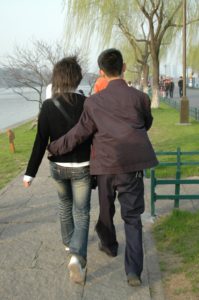
From the first moment you start walking along the West Lake, take in the plum blossom scented air, the refreshing breeze, see the wooden boats silhouetted against rolling hills which fade out in the faraway haze like a classic Chinese painting, the wisps of willow trees, the couples strolling arm and arm, the families delighting in their children and hear the laughter, the talented kite flyers, the bridal couple posing for pictures, you understand why Hangzhou is the city of love, the city of happy people who live longer and with less depression and stress than the national average.
West Lake, which is largely man-made, is not just scenic, tucked into nooks and crannies are some of the most important cultural sites, which pop up everywhere. Tucked all around the lake are gardens and former villas that have been turned into museums, memorials, tea houses.
In fact, West Lake is connected with many of China’s most noted historical figures, like the famous poet-governor Bai Juyi of the Tang Dynasty who was the first to organize a large-scale dredging; then, another famous poet-governor Su Dongpo dredged the lake and used the silt to form the graceful Su Causeway (the home of this famous man of letters and a poet “of bold and unconstrained style” has been turned into a memorial hall).
In the 10th century, during the Kingdom of Wuyue, King Qian Liu formed a 1,000-strong dredging team to look after the lake (I later visit the memorial temple for this fascinating leader, who rose from being a peasant to king, and who built irrigation system and “treated subordinates well and enlisted competent people”). The Qing Dynasty emperors Kangxi and Qianlong expanded the lake to its present proportions, visiting frequently and inscribing tablets of most of popular scenes.
Others who are remembered as national heroes and revolutionary martyrs buried around the lake, such as General Yue Fei, who resisted Jin invaders, and Qiu Jin, “an outstanding heroine, who fought against the decadent Qing court.”

The Northern Song hermit-poet Lin Hejin secluded himself until his death at the foot of Solitary Hill. Today, you can visit Solitary Hill, the only natural island at West Lake, where there are several important historical sites. One of these is the Xiling Seal Engravers’ Society, a hall of arts housing calligraphy of China’s famous artists. It also is where Emperor Lizhong of Southern Song Dynasty and Emperors Kangxi and Qianlong of Qing Dynasty built their palaces. We come upon a bridal couple posing for their photographs.
Legends of love abound: the Scholar Xu Xian and the Lady Snakewhite, Liangshanbo and Zhu Yintai (the eastern Romeo and Juliet), and Su Xiaoxiao at Mucai Pavilion (a romance of a beautiful and gifted girl – and have lent the name of “City of Love” to Hangzhou.
The Bai Causeway is the most revered, named for Bai Juyi (772-846), a governor of Hangzhou who built several of the causeways at the lake. The Broken Bridge, located at the east end of the Bai Causeway, is the place where folk legend has it that Lady Snakewhite and Scholar Xu Xian met.
As we walk across the Bai Causeway, I see a man flying a kite – a very sophisticated contraption and he is amazingly skilled. And I am reminded that the Chinese invented kite-flying. In fact, the Chinese invented rockets, gunpowder, fireworks, paper currency, ink, printing blocks, rice cultivation, cast iron, helicopter rotor and the propeller, and, as I recall, the seismograph (about two months after my visit, central China was rocked by the worst earthquake in 30 years, killing tens of thousands).
Capitalism, free enterprise and entrepreneurship thrive – the boaters who give rides on the lake, the pearl shop where you can buy a string of fresh-water pearls harvested from the lake.
Nothing is what I expect based on my prior experience in China – but then again, I had been completely dazzled by the speed of change between my first visit, in 1978, when a chink had opened in the Bamboo Curtain of China’s isolationism from the West, and my return just two years later, in 1980, when you could see the Four Modernizations literally sweep across the country. (Between my first visit and the second, I was amazed at how many people spoke English.)
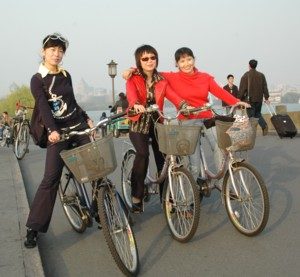
Things like colorful fabrics (I remember going to a fabric store in 1978 when the first bales were being sold when everyone was still wearing drab Mao jackets), Levi jeans and western dress, even walking hand in hand, playing Western music in the park, and studying books at the University were all just being revived after decades of being forbidden and all scholarship obliterated.
Today, the cars that clog the streets, the computer, cell phone and electronics stores, the leather and punk outfits, decorated jeans and odd hairdos on some young people, girls in short pants, some with exposed midriff, even couples embracing, let alone holding hands are dizzying changes from my last visit.
In those years, politics pervaded every aspect of society, in many ways antithetical to the cultural traditions stretching back thousands of years. In those days, all art and music was political – homes only displayed political posters with the message of the day. There was a forceful extraction from everyday society of everything else.
From what I can see today, even in these first few hours and through the rest of my visit, politics is no longer the overarching value or bulwark to everyday life. People, it seems, are not much different than we are. In fact, as I come to realize, they are (somewhat ironically) concerned about many of the same issues as we are: the cost of health care, the quality of public schools, the pressure to get into college, the rising cost of housing, what will happen to social security and retirement savings, the downturn in the stock market (the U.S. credit crisis and fear of U.S. recession on Chinese exports was a great concern).
You have to look hard for any reference of the Cultural Revolution – and if you did not know about Chinese history, you would not even think about it – but that whole chapter comes out in one of the small museums and memorials that ring the West Lake – housed in what used to be grand villas.
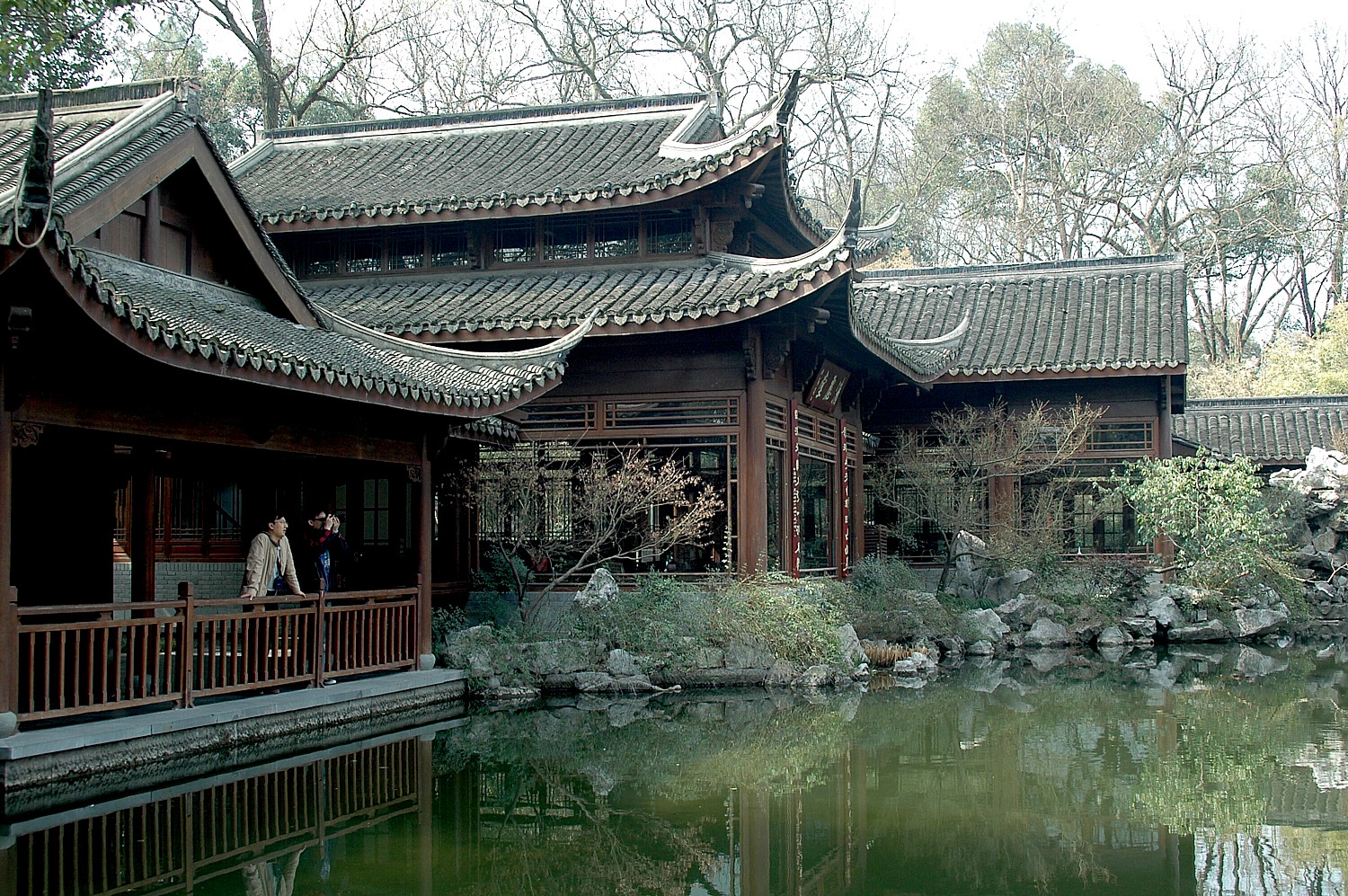
One of these is Mr. Jiang’s Villa, built 1901 & 1923 in Chinese and Western style. It is where a famous scholar, Ma Yifu, took up residence. I study the English cards that tell his story – how he came to St. Louis in 1903 “to find a way to strengthen China.” He studied Western philosophy and literature – Hegal and Shakespeare – and later went to Germany. When he returned to China in 1911, he brought with him a German edition of Marx’s “Capitalism”. He supported the Revolution led by Dr. Sun Yat-sen, writing articles to popularize Western progressive ideology. After that, he devoted himself to the study of textual criticism, argumentation, ancient philosophy, Buddhism and literature. He was hailed for his work during the “Anti-Japanese War” as World War II is known. He briefly served in the Ministry of Education but resigned because he couldn’t stand the bureaucracy. He served as the Director of Zhejiang Research Institute of Culture and History from 1953 to 1964 and was known as a great master of the Confucian School and philosophy of the times.
But then the Cultural Revolution came, and he did not fare well. I take note of one card, “In the beginning of the 10-year long Cultural Revolution, Ma Yifu was falsely framed as ‘The Old Fogy of the feudalistic society’ and was expelled from Jiang’s Garden.” He sold his works of calligraphy “for money shortage and made his due contribution.”
Ma Yifu never recovered and died in 1967. In the reversal that took place during the Four Modernizations, his legacy was resurrected and a memorial service was held in his honor in 1989.
I see this museum as part of a policy to resurrect academics and re-ignite a reverence for history and learning.
I think of this when I am back at my hotel, and watching television (yes, there is a remote control TV). There is no CNN (perhaps there would be at the Grand Hyatt across from West Lake); there is an English-language Chinese news program and I switch to it because there is very little else to watch (most of the American movies they show are violent and most of the Chinese programs are dubbed in Japanese or else are in Japanese and dubbed in Chinese, though I do get to see a few good American movies).
But I happen to listen to an interview with a high-level official who is talking about China’s need to break from its dependency on manufacturing and export. He notes that this is deleterious for China’s resources, for its pollution, and because downturns in foreign markets (such as the U.S.) cause upheaval. Instead, the government will launch an initiative to become the producers – the creators and inventors – and will spend on Research and Development and on tightening its laws governing intellectual property.
And then I am reminded about the man flying the kite and all the rest of the inventions that China gave to the world, including paper money.
One of the best ways to enjoy West Lake is to take a boat ride – and there are many different variations, including a wood boat powered by an oarsman – which brings you close to the three small, manmade islands in the West Lake. It occurs to me that taking the boat, you become part of someone else’s idyllic scene.

The boat brings us up close to Yingzhou Islet, a small island in the lake built in 1607, famous for the three stone pagodas that were set into the water in 1621. Each pagoda has five round holes and when there is a full moon, and a candle placed in each of the pagoda, the light mingles with the moonlight, from which comes the name, “Three Pools Mirroring the Moon.” I’m especially impressed when I see the same three pagodas on the Chinese currency.
Mid-Lake Pavilion, built in 1552, has an ornamental stone arch with Qing Dynasty Emperor Qianlong’s inscription, “Cong Er” which means “endless romance here.”
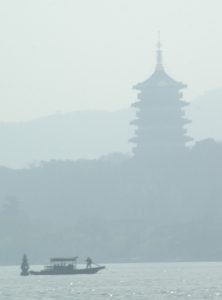
One of the most picturesque elements on the lake is the Leifeng Pagoda, originally erected in 977 by Qian Hongchu, the last King of the WuYue Kingdom. It is so stunning during sunset that the site named “Leifeng Pagoda in Evening Glow.” The original pagoda collapsed in 1924 and the new one, 72 meters high, was reconstructed on the original site in 2002 with a museum at the base where unearthed relics are exhibited.
I love the poetry of the place with such names as “Lotus in the Breeze at the Crooked Courtyard,” “Yellow Dragon Spitting Green,” and “Precious Stone Hill in the Twilight of the Setting Sun.” Another site, “Autumn Moon over the Calm Lake” is so-called because it is the best place for enjoying the moon during the Mid-Autumn Festival.
For more information about travel to Hangzhou, contact Hangzhou Municipal Tourism Commission, http://eng.hangzhou.gov.cn/
See also:
Hangzhou, China: Marco Polo’s ‘City of Heaven’ As Alluring as Ever
____________________
© 2016 Travel Features Syndicate, a division of Workstyles, Inc. All rights reserved. Visit goingplacesfarandnear.com and travelwritersmagazine.com/TravelFeaturesSyndicate/. Blogging at goingplacesnearandfar.wordpress.com and moralcompasstravel.info. Send comments or questions to [email protected]. Tweet @TravelFeatures. ‘Like’ us at facebook.com/NewsPhotoFeatures
